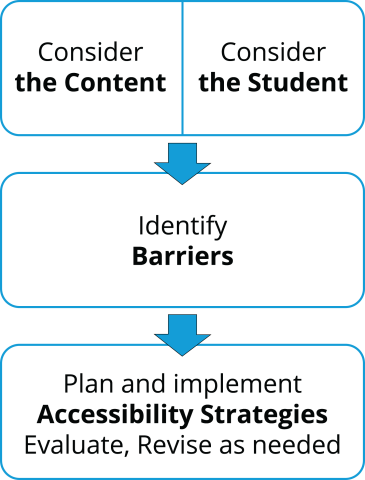Math Accessibility Framework
Description
The Math Accessibility Framework is a planning tool for general and special educators to use when planning math lessons for students with disabilities and students who struggle. It addresses:
- The goals of the lesson
- The student’s strengths and difficulties
- Strategies that align with student needs
- Upholding rigorous academic goals
- Fostering independence for students
- Increasing positive impact on learning for all students
Why Try Something New?
Have you ever discovered a strategy or tool that you got really excited about and immediately tried with your learners? Have you ever defaulted to procedures or strategies provided with a textbook because it was already set up for you?
When you tried out those strategies, did you find yourself just as underwhelmed by the results as when you were doing what you were before you sought out new ideas?
This happens for many reasons, all of which have to do with a misalignment between the strategy and the learning needs of the student. The new strategy or approach might pique interest, add a little color to a confusing or difficult task, or simply disrupt routines. But if it is not aligned with the barriers to learning, it will not help students.
The Math Accessibility Framework is a way of thinking about
- students’ strengths to leverage
- students’ difficulties to support
- barriers in the learning environment or lesson that prevent achievement
- strategies that align to students and those barriers
When we align strategies to learners, engagement and math understanding increases.
Why Use the Framework?

A simple workflow diagram that asks the viewer to consider the content and consider the student as the first step, identify barriers as the next step, and then ultimately plan and implement accessibility strategies and evaluate/revise as needed.
Math learning difficulties are common and worthy of attention. Math is a language we use everyday. It helps us to understand the world, think critically about problems, make decisions and connections. The effects of math failure throughout years of schooling, coupled with math illiteracy in adult life, can seriously handicap both daily living and vocational prospects (Garnett, 1998).
Students may also struggle in math class for reasons unrelated to mathematical knowledge. Below are six areas that can affect mathematics learning:
- Conceptual
- Language
- Visual-spatial
- Memory
- Organization
- Attention
By utilizing the Math Accessibility Framework, students can be supported and build independent strategies. It can also help avoid unintentionally lowering expectations for appropriate goals and losing the rigor of the lesson.
Documents
Math Learning Disabilities (Google Doc)
How do I Get Started?
Getting Started:
- Download and read the Math Accessibility Framework Overview to get a brief summary of how to utilize the framework and planning sheet.
- Watch the video to get a more in depth look at the planning process and how to think about each section of the framework.
In your first attempt to implement the framework, consider:
- focusing on one student
- starting with one lesson that you feel comfortable teaching
- choosing a couple of strategies with which you are familiar
- using the Accessibility Lesson Planner to document your planning
Documents
Math Accessibility Framework Overview (Google Doc)
What Strategies Could I Use?
With a wide range of learning difficulties within each classroom, determining which strategies might be helpful for students can be challenging. Collaboration between general and special educators can aid in making sure both the student and the math goals are supported.
- Special education teachers can offer a background in helping students overcome learning difficulties. They might also have experience working with a particular student or a student with similar learning difficulties.
- Math teachers know the math goals, pre-skills needed, and how the concepts connect. They will make sure students are working toward rigorous math goals.
You could also reference the Accessibility Strategies for Mathematics document. It identifies six areas in which students' strengths and needs strongly affect mathematics learning and offers strategies that can be utilized to overcome barriers in these areas (EDC, 2007). It is not an all-inclusive list, but it can start the conversation and may spark other ideas to assist in overcoming barriers and impacting the learning for all students!
Documents
Accessibility Strategies for Mathematics (Google Doc)
Are There Other Planners to Utilize?
The Accessibility Lesson Planner is just one of many that can be utilized.
- Find more formats and layouts on the Education Development Center’s Addressing Accessibility in Mathematics webpage
- Download the digital planner to create one that fits both your needs and the needs of your students.
The Framework Could Be Used for Other Subject Areas, Too!
While the EDC developed this framework for math lessons, Michigan educators have said that it would also be useful for any subject area. The consideration of the content, student, barriers, and strategies is good practice to support students who struggle with any lesson or content area. Feel free to share this information with colleagues looking to better support students with disabilities.